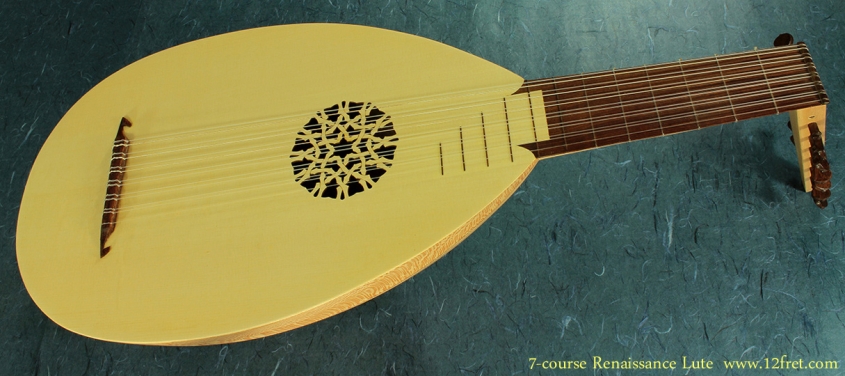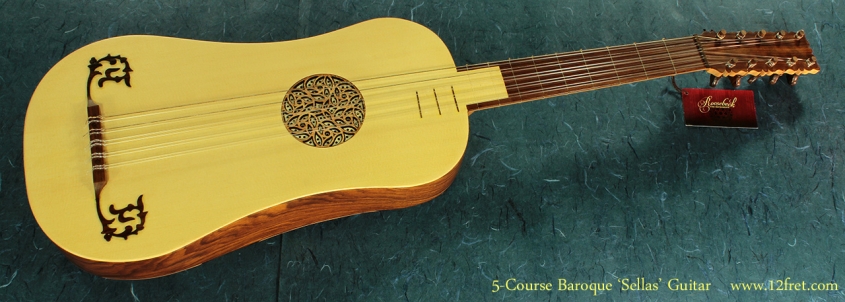Instrument Categories: Classical and Flamenco, Guitars, Other, SOLD
Baroque Guitar and Renaissance Lute: NAMM show discovery !
Every year at the LA NAMM show we find something unique and wonderful. Mid-East Music specializes in handcrafted historic and ethnic instruments. Unlike other sources we’ve encountered, they understand and service the instruments they sell and control and participate in the manufacture process. Hand made in Pakistan, these instruments are remarkably cleanly built: accurate joinery, clean fit and finish. We were VERY impressed by the overall quality and appearance and the prices are a fraction of what we commonly see in second hand historic Lutes and Baroque guitars.
“At last I can offer a completely playable historic Lute and Baroque guitar for a price that “makes sense” to most of my clients who simply want to experiment with this era of music. These instruments are “the real thing” at an affordable price. These instruments even come with lightweight but solidly made hardshell cases!” – Grant MacNeill, President The Twelfth Fret
7-course Renaissance Lute, Zachary Taylor Design
- 7-Course Lute, Lacewood, model Code: LT7CZT
- 15 nylon strings in 7 courses.
- Soundboard: European Spruce
- Back: solid lacewood staves
- Fretboard: rosewood
- Maple neck & pegbox with ebony pegs.
- Scale 600mm
- Nut 67 mm
These Renaissance lutes are designed by Zachary Taylor and based on research done on an instrument made by Hans Frei in Bologna circa 1540.
The original is in the Warwick Museum in England. Apart from shortening the string length from 670mm to 600mm, for ease of left-hand fingering, the instruments follow Hans Frei’s principles of construction. A well padded, semi rigid case and instruction book included.
Baroque Guitar, Sellas, 5-course, Zachary Taylor Design
- 10 strings in 5 courses, model code: GBSLAZT
- Soundboard: European Spruce
- Back: solid alternating rosewood & Beechwood staves
- Fretboard & bridge: rosewood
- Beechwood neck & pegbox with rosewood pegs.
- Scale 660mm
- Nut 45 mm
The 5-course guitar designed by Zachary Taylor is based on instruments made by Giorgio Sellas as seen in the Ashmolean Museum in Oxford, made in 1627. It was examined and measured for the purpose of producing a representation of this exquisite instrument.
The Sellas design uses the arched back, similar to the lute, stave construction similar to traditional barrel makers; strips tapered at each end. Alternating woods with ebony fillets separating them creates a distinctive appearance characteristic of Sellas’ work.
Some modifications were made to the original design but the utmost attention was paid to the basic construction and materials to bring about a faithful representation of this beautiful guitar.
The Baroque guitar represents an interesting transition between the Renaissance lute and the modern 6 string guitar as we know it today. Commonly called the Baroque guitar variations on this instrument were played well into the Romantic era and in the early 1800s they were gradually replaced with the modern “Romantic” guitar.
More About The Baroque Guitar from Mid-East Music:
The term ‘Baroque’ is one of convenience that musicologists and historians use to place the chronological development of the guitar in a particular period, taken to be from early 17th to late 18th century.
The word ‘course’, when used in the guitaristic sense, refers usually to more than one single string. A course is usually two strings, but may be three on certain instruments. Typical string arrangements for the Baroque guitar were 5 double-string courses; in some cases the pairs were tuned in unison and others in octaves, similar to its ancestors the lute and vihuela. It is not uncommon to use just a single string for the highest course, like the Renaissance lute. This may well have been a tradition imposed due to the difficulty in producing a matched pair in the small diameter string material. The high single string is often called the ‘chanterelle’.
Pairs in a course may be tuned in unison or in octaves. Where octaves are used for the lower strings, it is most usual to have one of the pair tuned an octave higher than the normal, fundamental, string. This arrangement produces a bright and lively sound.
Each end of the Baroque guitar era was overlapped by its relatives, the 4-course Renaissance guitar at the beginning and the early Romantic guitar at its close. The latter used single strings rather than double and a 6th (bass) string was added at this time, transcending to the, now conventional, classical guitar. Several varieties of tuning was used for the guitar during this period, but probably the easiest way to understand it is to compare it with the modern guitar. If the lowest bass string were to be removed, leaving the five highest strings, this would correspond to the tuning of the Baroque guitar. Individual players may use octave pairs to suit the period or type of music they prefer.
Compared with the modern guitar, the body of the Baroque version was narrower and lighter, although the scale length was often longer. Strings were of gut, as were the frets, which were tied around the neck. Tapered tuning pegs were shaped similarly to those used by the lute or the violin and are installed in the flat peg head.
Characteristically, the soundhole is decorated with a rose made from multiple layers of thin materials that may include wood, parchment or combinations of both.
Music for the 5-course guitar was written in various forms of tablature, an early graphic style of writing, using lines and symbols. Tablature in the well-established French, Italian and Spanish forms was also used for Baroque guitar, with composers from those respective countries such as, Robert de Visée, Francesco Corbetta and Gaspar Sanz. It is worth noting that a suite of pieces by Sanz was the inspiration for the ‘Fantasia para un Gentilhombre’, by Joaquín Rodrigo written at the request of Andres Segovia.
The scale length is 660mm. There are 9 nylon and 3 wooden frets. This instrument features an ebony nut and fingerboard, and a spruce soundboard.
A well-padded semi-rigid case is included.
Rolf Lislevand plays A.Stradivari Sabionari, 1679 guitar – Santiago de Murcia – Tarantela |
Baroque “Sellas” Guitar by Zachary Taylor (video performance by Howard Wallach) |
- Year: Current
- Class: New
- Serial Number: varies as New
- Country of Origin: Pakistan
- Condition: Brand New
- Date Posted: 10/02/2013
- This instrument has been sold
- Not Consignment
- Including Hard case


















